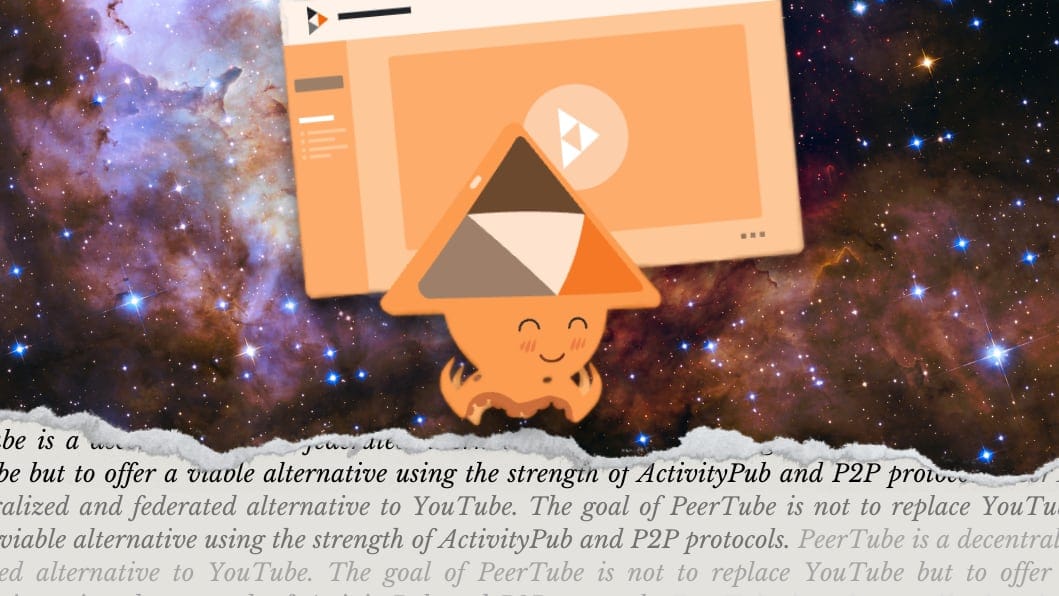The Fediverse has its own full-fledged YouTube alternative that possesses some unique superpowers thanks to ActivityPub. In the previous article in this series I covered what it’s like to use PeerTube from the point of view of a casual user:
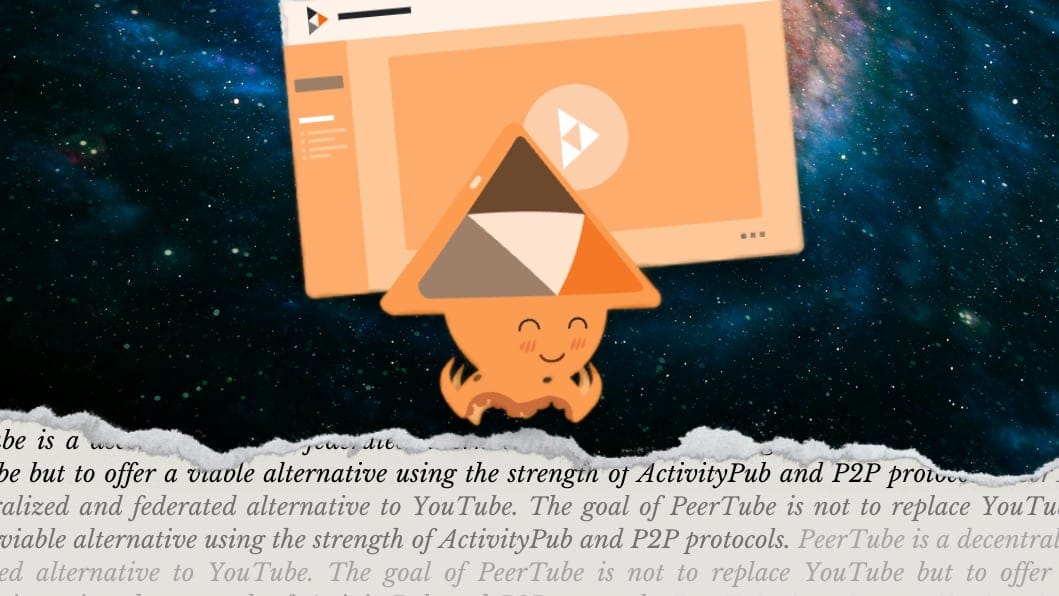
Today’s post will discuss: how to use the software as a video creator – and its advantages over video hosting platforms by Big Tech companies.
I initially thought about having a 2-part series about PeerTube, but there is so much to discuss, I may stretch the posts into a 4-part series. Creator Paige Saunders (of Canadian Civil and FediHost) generously answered my PeerTube questions in a long, illuminating interview. This would be included in part 3: speaking to seasoned PeerTube creators who also use YouTube and could compare and contrast experiences. In part 4 I could discuss what it’s like to set up my own PeerTube instance – because I’m super tempted to do so (read: I probably will, soon).
But first! Let’s address what it’s like to use PeerTube as a creator joining an existing instance.
Why should creators use PeerTube?
What are some unique advantages of PeerTube compared to offerings by Big Tech companies?
Putting creators in full control of their videos - and data - in an environment free of advertising, opaque algorithms and dark patterns. There is no tech behemoth behind PeerTube, no entity surveilling what people watch or click on in order to build an advertising profile about them or to serve them videos that will keep them glued to the platform for as long as possible. Heck, there is no central PeerTube - that is the name of the software powering thousands of independent servers hosting federated videos.
When I first started using Mastodon in October 2022, I had a very limited understanding of the Fediverse and the magical powers of ActivityPub. I was simply looking for an alternative to Twitter (RIP). What I have learned in the ensuing 2 years has turned me into a total Fediverse cheerleader. “You can comment on a photo on Pixelfed and that comment will sync across servers and appear under the post on Mastodon, Akkoma and Friendica feeds too? What is this sorcery?” pretty much sums up the constant sense of awe I feel towards ActivityPub - which never gets old.
I find it impossibly cool that I can follow a PeerTube video channel from a microblogging account and thus this way I will see videos of creators I’m interested in appear in my Mastodon feed, as soon as they are published. And I can watch a PeerTube video right there, on my Mastodon feed, like it, even comment on it - with the comment seamlessly appearing on the video’s PeerTube page as well. ActivityPub is pure magic.
Tech features aside, I owe a lot of gratitude to the Fediverse and the lack of algorithmic feeds because I feel that now my "followers" (I actually prefer the non-cult-like term "subscribers") can truly see my posts and interact with them. There is no opaque algorithm getting in the way. It's incredibly refreshing to publish a link to a blog post on my Mastodon account and see people interacting with it and commenting on it in numbers that far surpass anything I experienced on Big Tech commercial platforms. If PeerTube could actually give the same exposure to my videos - and generate interesting conversations, like my blog posts do on Mastodon - it would be a total game changer.
A Fediverse cheerleader struggles with too many accounts
As a Fediverse enthusiast, who is about to start working on a video series about it, PeerTube checks all the boxes for an ActivityPub software that I should embrace. But here’s an issue: I had been reluctant to create an account for another ActivityPub project. As the Fediverse matures, its biggest drawback to me - for now - is the lack of a single identity. At FOSDEM in February I attended a talk by Sébastien Rosset about ActivityPods which could empower you to have one account for all your social needs. The projects’s website states: “With ActivityPods, you have only one profile, one outbox, one inbox and one list of followers - all in a single place. Applications connect to your Pod to post activities, read the inbox and fetch data.“ Sounds wonderful but we’re not there quite yet.
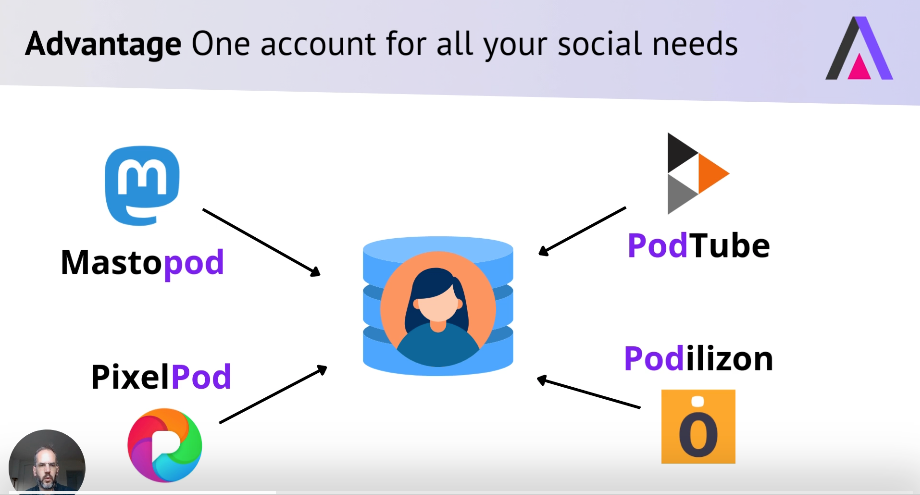
I spent about a week brainstorming FOSS solutions that would let me publish my videos in a way that allows me to retain full control over my data. On my GoToSocial account (where I recount my self-hosting adventures) I wrote:
After spending 24 hours doing Olympic-level mental gymnastics, trying to find a way to self-host my videos NOT on PeerTube (I considered Wordpress's VideoPress, embedding videos from NextCloud, uploading straight to Ghost...) I have capitulated.
Yes I will go with #PeerTube.
Deciding factor: the need to have subtitles (not so easy if you host your own videos).
But what about uploading straight to Mastodon, you may wonder? Well, Mastodon has a 99MB video upload size limit, which seems like a lot but is nothing when you factor in video length and resolution. For example, a 4-minute video I produced a little while ago ended up being 450MB in size after I optimized its compression for the web (at 1080p, 20Mbps). And you can’t turn on subtitles there or adjust the speed of a video on Mastodon.
So PeerTube it is, hesitations and all.
How do you set up a PeerTube account? Let’s find out.
Step 1: Join an existing PeerTube instance
Like all other Fediverse projects, in order to create a PeerTube account you need to first select an instance for it. The Fediverse is decentralized and made up of thousands of independent servers. For PeerTube, it’s worth doing a bit of research first to find something that is a good fit for your style and ultimate goals. The site Fedidb has an always up-to-date list of popular PeerTube instances:

Disclaimer: I had a rough beginning with PeerTube. The first instance I joined - that shall not be named - was filled with pirated content proudly displayed on its “Discover” page. I found PeerTube channels that boasted having “full films”. This included independent documentaries – which I personally found a little heartbreaking from the POV of an indie filmmaker.
I used to have to play a game of Whac-A-Mole with my documentary The Illusionists - which took me 8 years to make from start to finish - whenever I saw it pop up on illegal websites. I lost count of how many DMCA takedown notices I had to file. People may think that pirating movies is harmless “because filmmakers are wealthy” but this couldn’t be further from the truth. I didn’t get paid to make this film, I sacrificed a lot personally, professionally and financially so the documentary could see the light of day… similarly to many colleagues who are independent filmmakers. So seeing people scrape films and upload them on streaming sites feels like a stab to the heart. A lack of respect for the craft - and for my colleagues.
I couldn’t possibly stay on a PeerTube instance that hosted so many illegal documentaries - from an ethical perspective but also because of the real risk of the whole server being shut down if it was sued by TV or film studios. That first instance I joined hosted dozens of PBS science and nature documentaries - which makes no sense, since they are available for free on PBS’s website - without geofencing.
Saddened by the cavalier pillaging of copyrighted films and documentaries on that first instance, I immediately knew I had to find another home for my videos. After a bit of research I came across MakerTube.net, which describes itself as “home for makers, musicians, artists and DIY folks.” The first item on its terms of use? “Only content may be uploaded that was created by the user and the user is the owner of the copyright.” And I like its other values: “No content condoning or advocating for the oppression of members of marginalized groups, or general discrimination of groups based on characteristics like gender, race, disabilities, nationality, education, religion etc.” I knew I had found my home.

The high costs of video & slowing down sign-ups
Hosting videos requires a lot of storage space and computing power to transcode clips. MakerTube - like several other PeerTube instances - doesn’t have open applications. The instance asks prospective users who want to set up an account to first write in, explaining why they want to join the instance:
Please put something meaningful in the request form about the type of content you would like to publish. MakerTube is not for everyone but a home for makers, musicians, artists and DIY content creators in the broader sense. We don’t have the resources to accommodate everyone.
I applied for an account - and in a few hours I was accepted.
Step 2: set up your profile
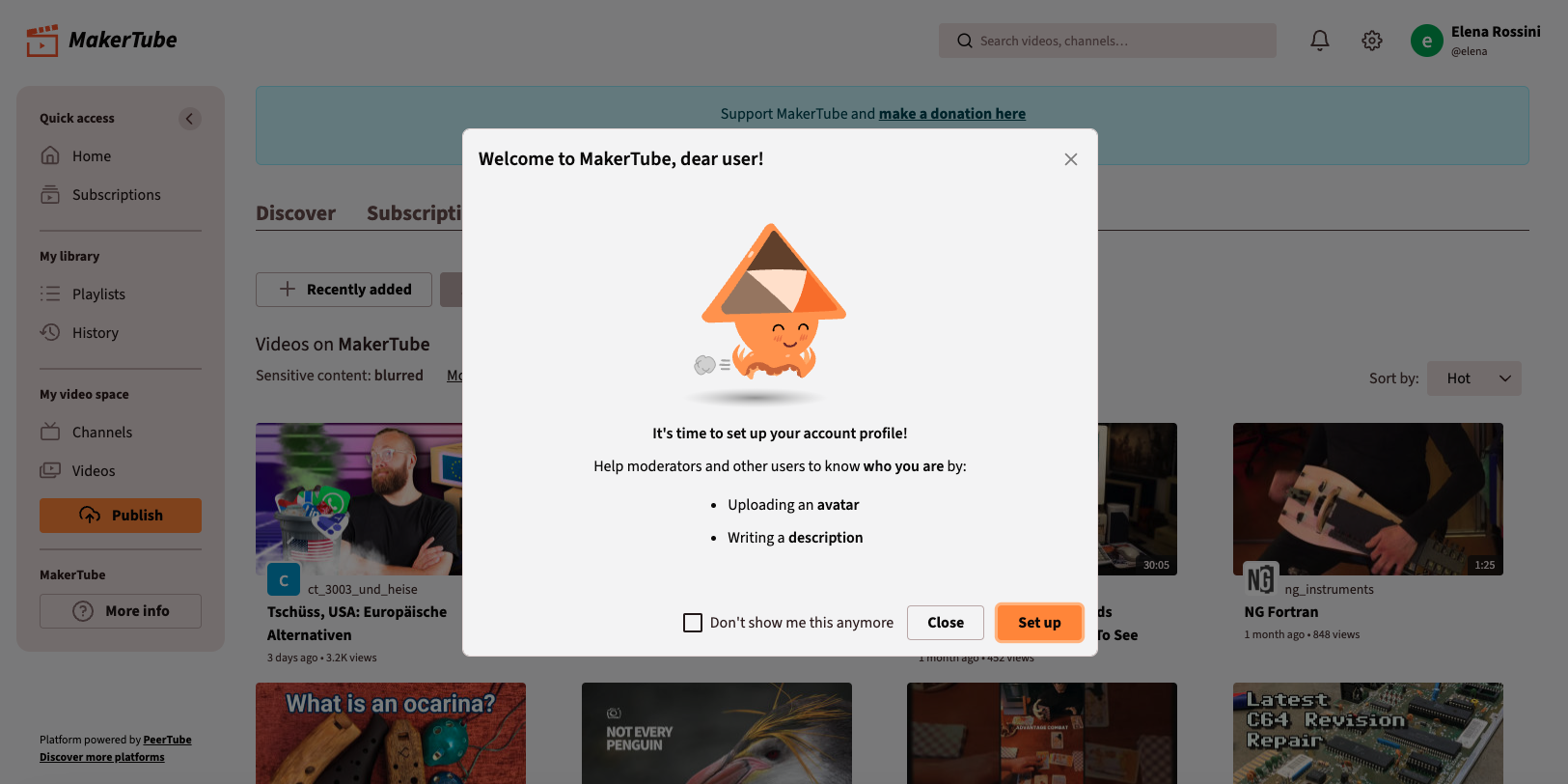
Like any other social media platform, when you first join a PeerTube instance you are asked to upload a profile photo, fill out a bio and - this is particular to the software - name your first channel. Channels are a way to organize your videos by topic. You should have at least one… and viewers and Fediverse users alike can choose to subscribe to all your channels or just a specific one.
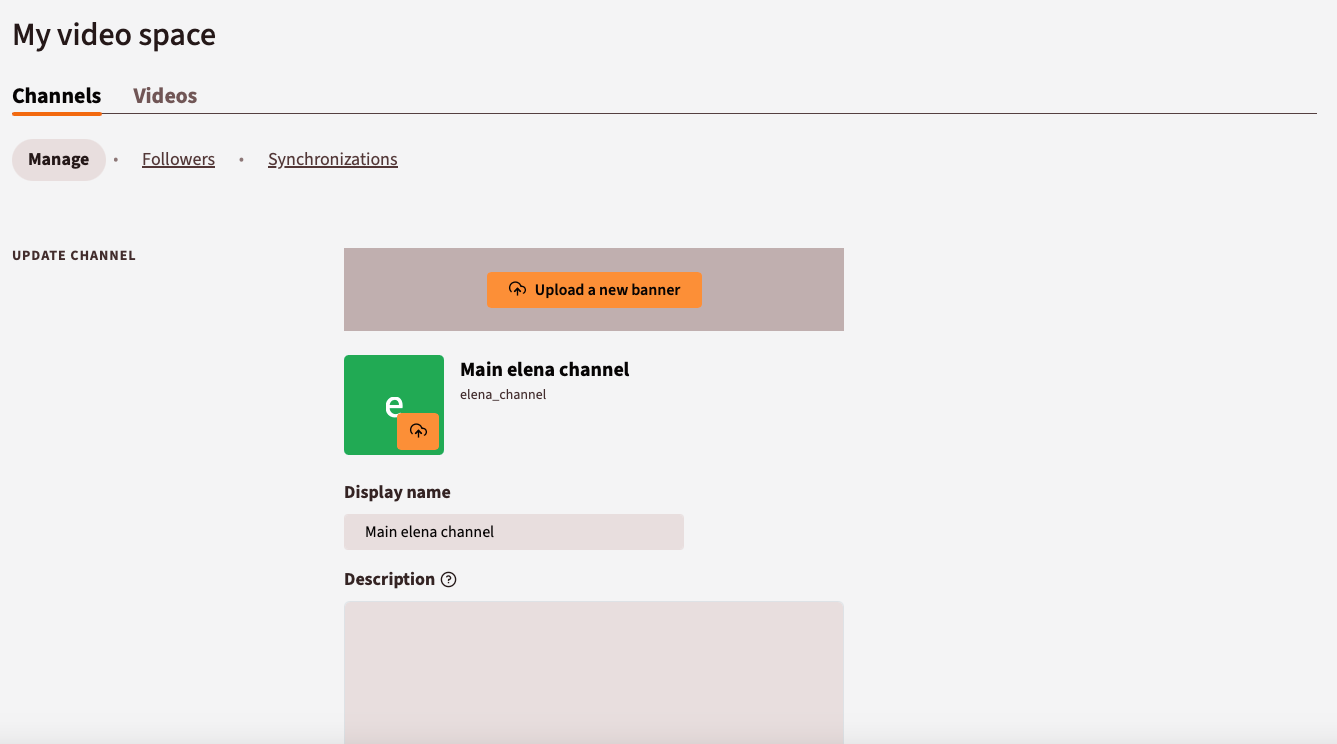
Step 3: upload your first video
When you are ready to upload your first video, you click on the button “Publish” (bright orange in my MakerTube dashboard) in the sidebar.
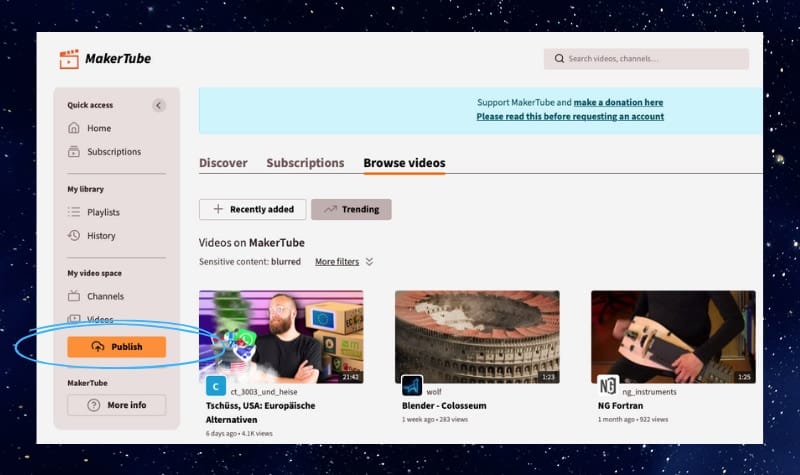
A new page appears with the following choices:
- Upload a file (from your device)
- Import with URL
- Go live (yes you can livestream!)
Then you select the channel you want the video to appear in.
And lastly, the visibility of your video. These are the options:
- public (anyone can see the video)
- private (only you can see the video)
- unlisted (shareable by private link)
- internal (only users of your instance can see the video)
- password protected (only people with the password can see it)
I have many videos on my Vimeo channel. I decided to import the latest one – The Power of Visibility – using the URL import function.
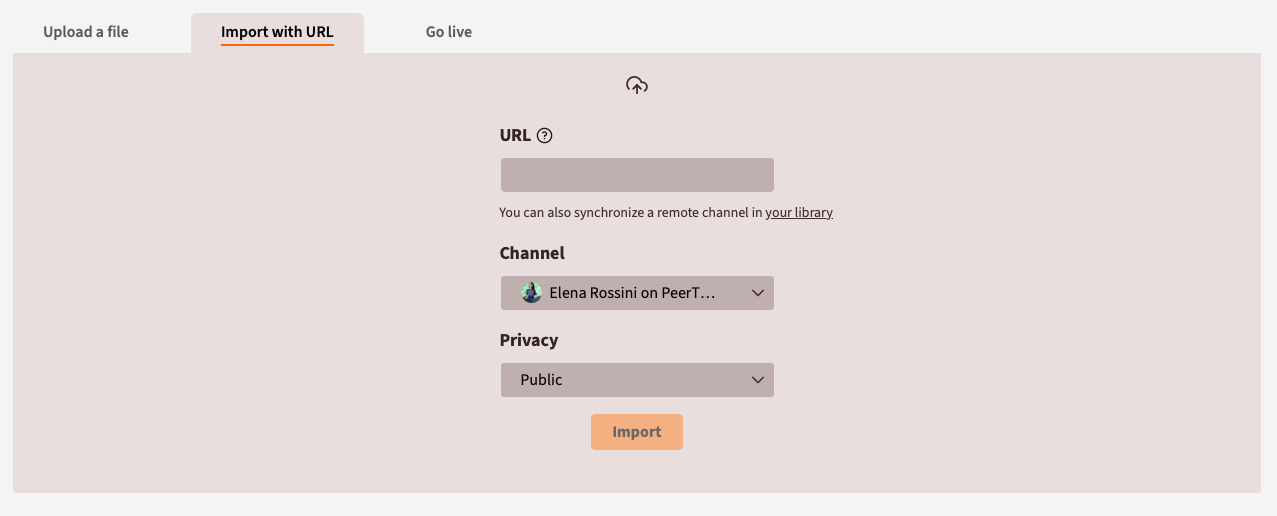
I was amazed by how quick and seamless the experience was. PeerTube immediately grabbed the video description and even the video’s subtitle file!
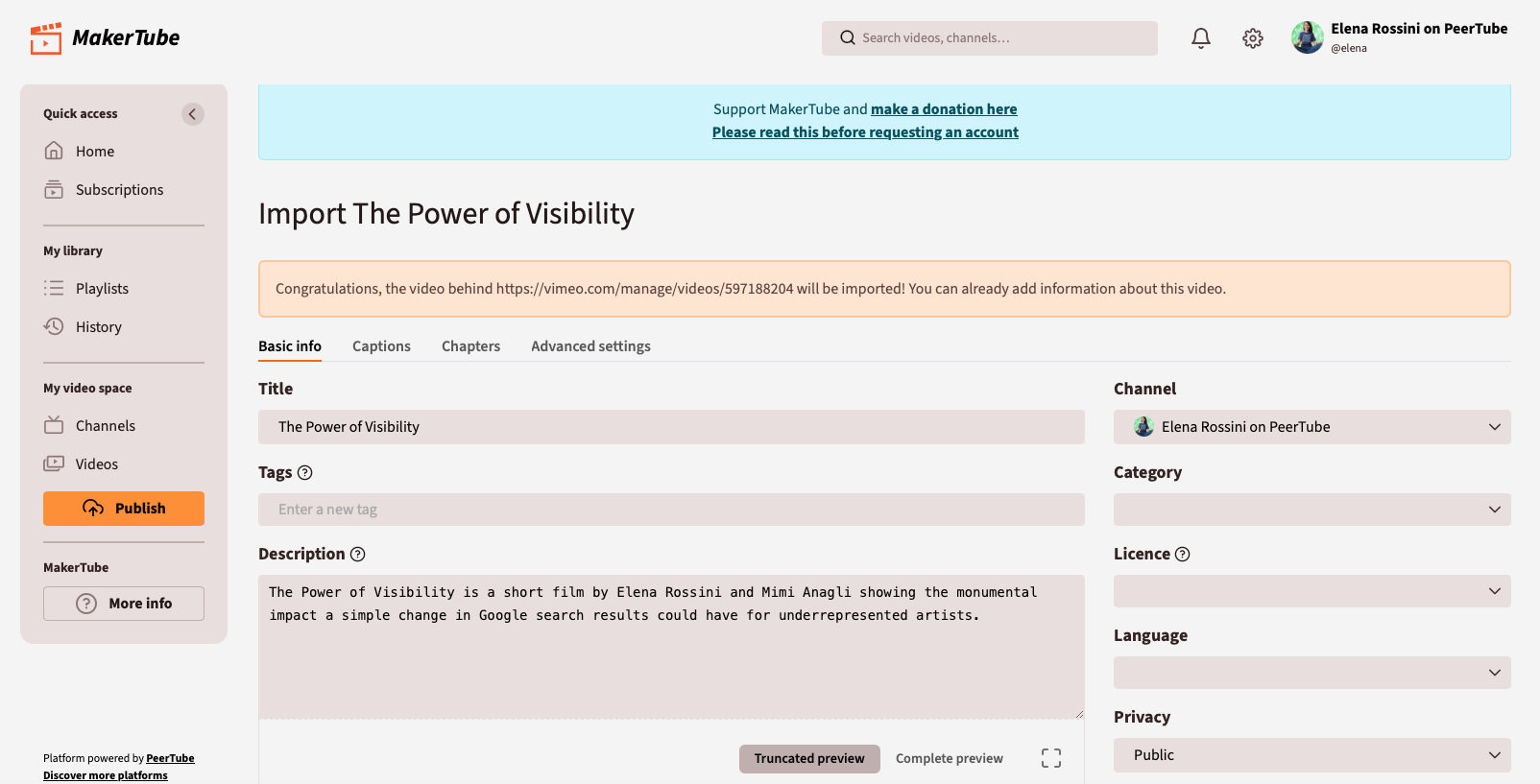
I was a little confused by an empty text box under the video that said “Support.” But then I clicked on the question mark next to it and realized it’s a space where creators can explain to their viewers how you can support them financially. There isn’t one single solution for supporting creators. Framasoft - maker of PeerTube - explains on its FAQ page:
This button displays a frame in which people who upload videos can display text, images, and links freely (link to Patreon, Tipeee, Paypal, Liberapay...). We did not go any further, as we refuse to tie our code to a particular content funding method, that might not fit all communities and deter others.
I didn’t put anything in the support box, I just wanted to see the video upload function at play. I went ahead with the “Import via URL” method, clicked on a button and simply sat back, waiting for my instance to transcode the video. I got alerted a few minutes later via email that the video was successfully published on my MakerTube profile.
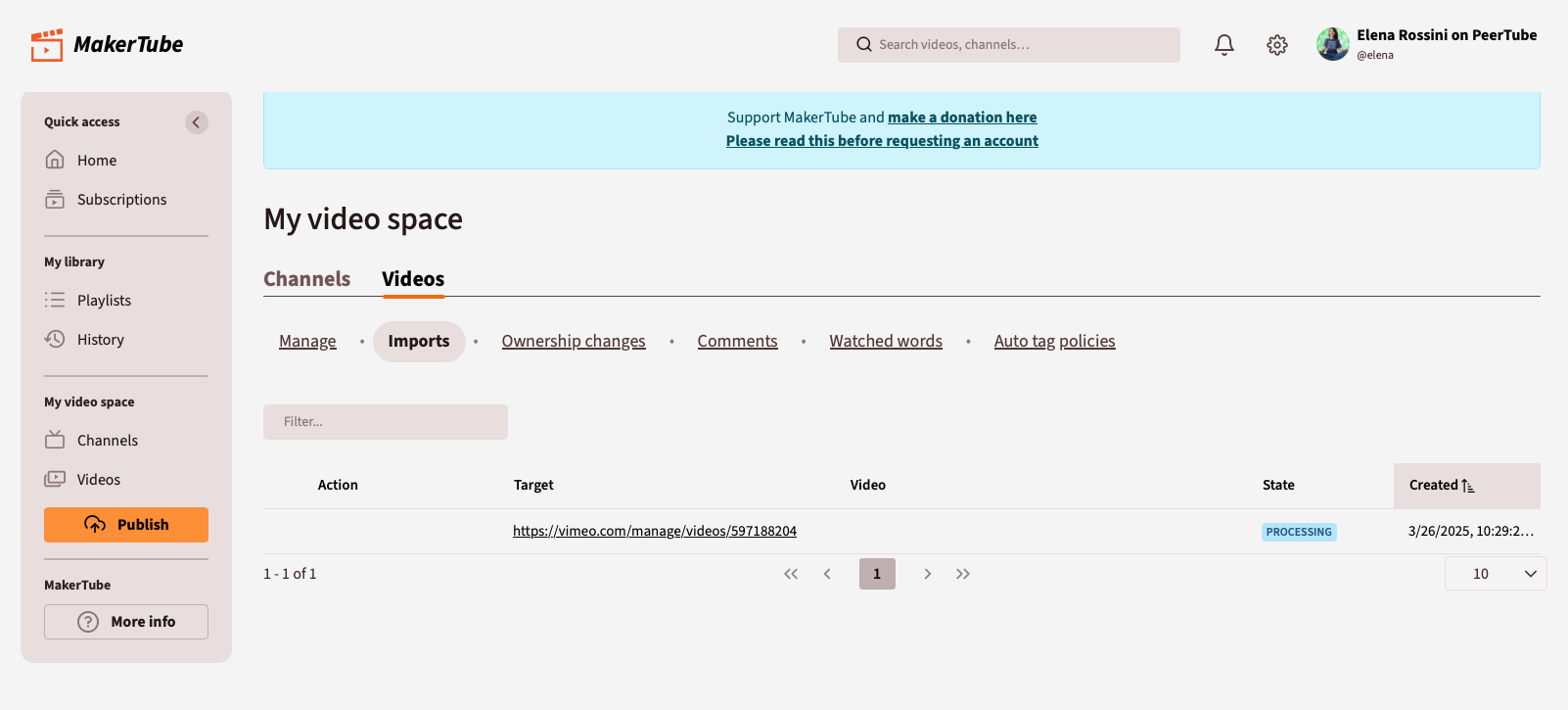
I would rate the experience 100/100. The speed and convenience of the import process was awe-inducing.
The quality of the video was great and so was the experience streaming it on my desktop computer.
So of course I immediately went ahead and imported a second video by copying its URL from Vimeo. Confirmation about the two videos’ successful import was displayed on my dashboard:
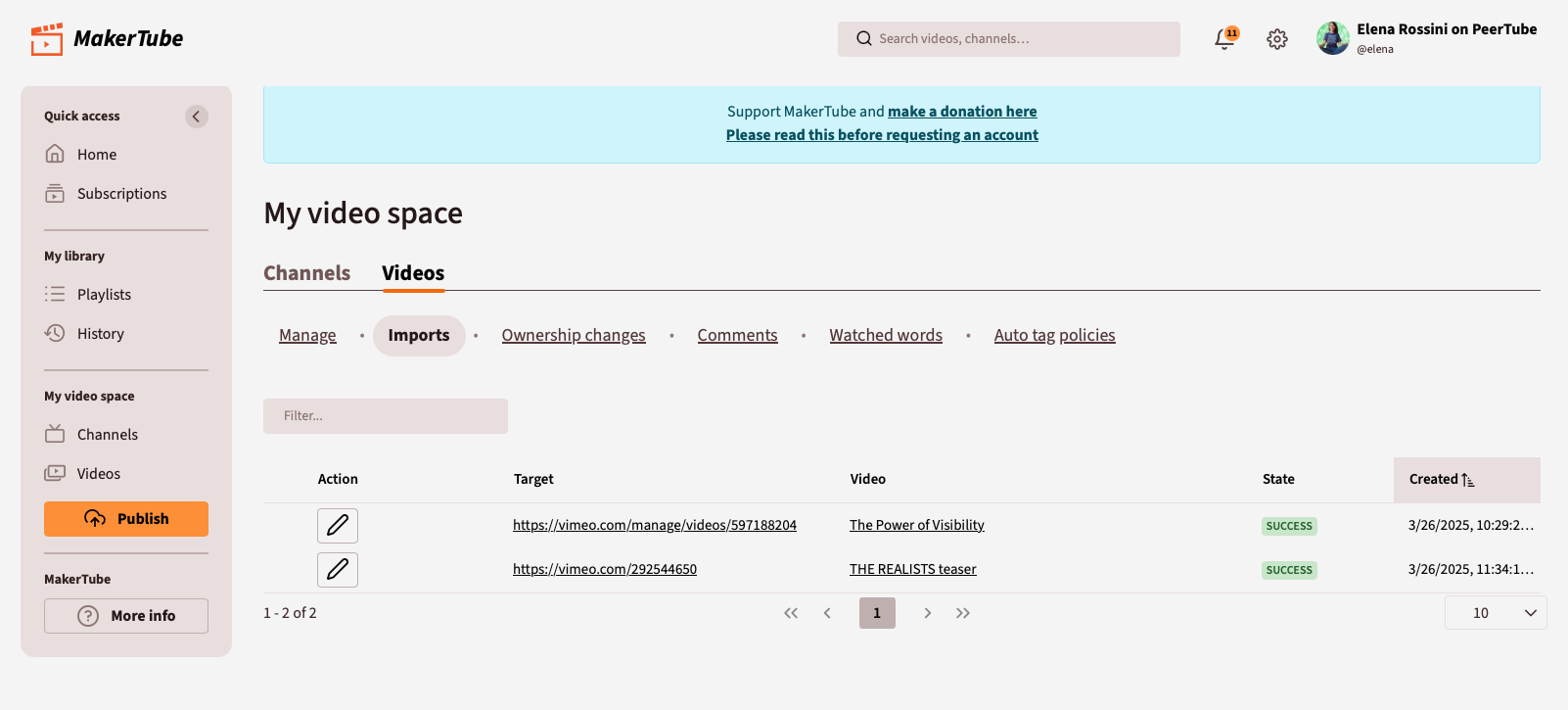
And here is how the videos appeared to the public on my PeerTube page:
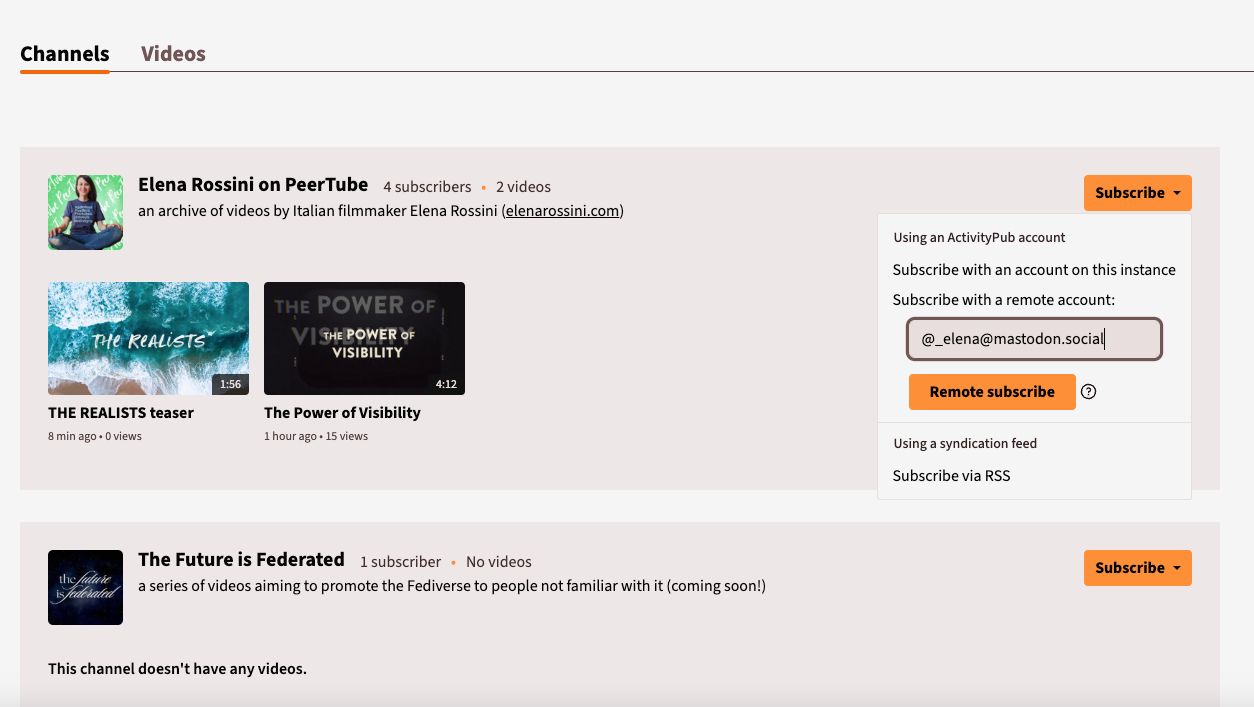
I ran a couple of tests and I was easily able to follow my PeerTube account with my Mastodon and Friendica accounts… but not my GoToSocial account (the two software have a well-known bug that will hopefully be resolved soon).
Step 4: Financially support your instance
As soon as my first video was successfully uploaded to MakerTube I knew what I had to do: make a donation to my admin to offset the costs of storing, transcoding and streaming my videos.
Thankfully, MakerTube has support information readily available at the top of every page... and the support message immediately pops-up when you are approved by their instance and attempt to login for the first time:
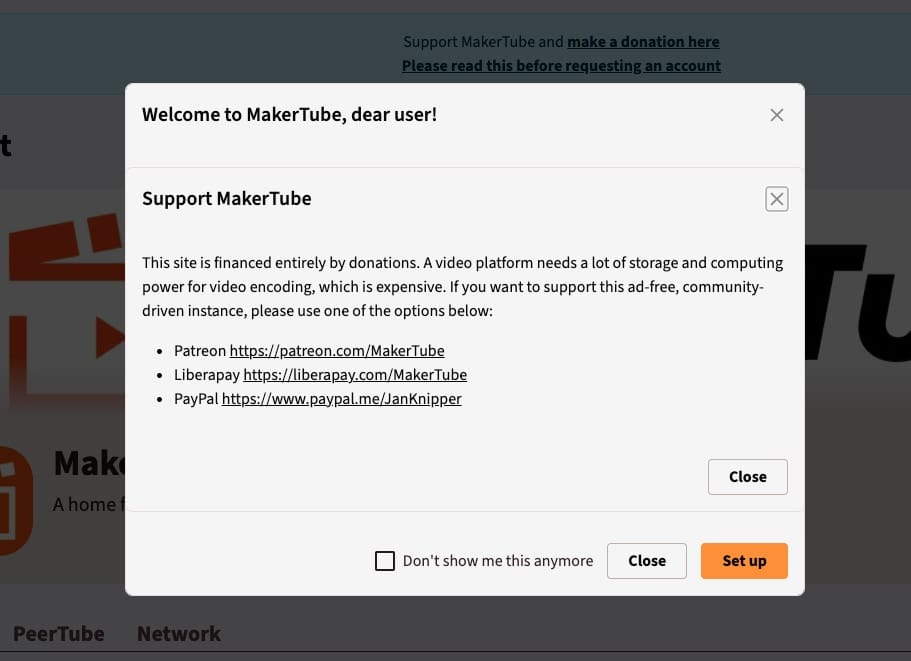
If I were to run my own PeerTube account on a VPS it would cost around 5 Euros a month. So that’s the monthly donation I decided to set for MakerTube.
Step 5: Embedding PeerTube videos on your website
And now, time for the ultimate test for creators. What is it like to embed a PeerTube video on your website? How easy is it and what is the video quality like? Let’s find out.
I have had a Wordpress site about my work for ages. Maybe since 2010? I started designing and developing websites for myself and for others in my teens and I’ve become really proficient at it (if I may say).
A video I recently uploaded to my PeerTube account is the teaser for The Realists. To embed it on my Wordpress site I simply have to grab the embed code from MakerTube and replace the Vimeo code I currently have:
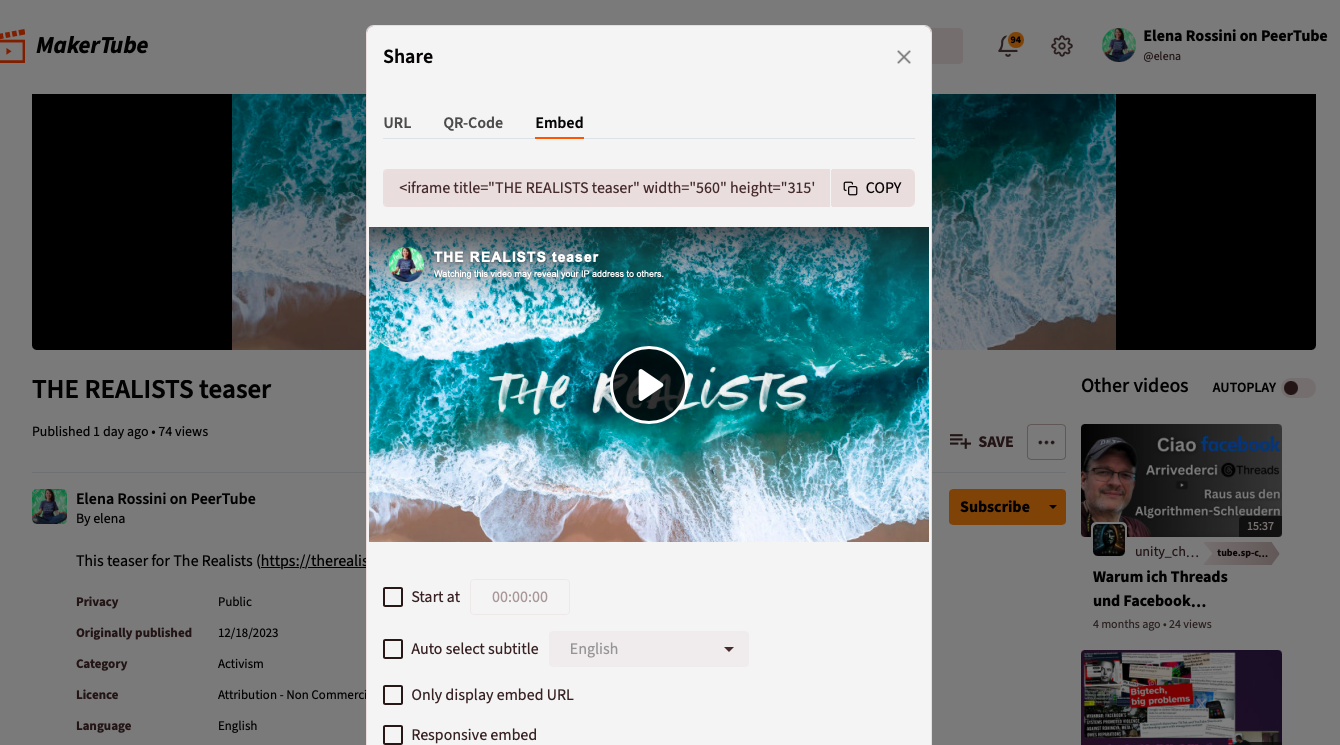
Swapping the video players (from Vimeo to PeerTube) took a couple of minutes but I stumbled upon a bug: if the settings have the option “auto select subtitle” checked, only the audio plays but the video remains a black screen. I A/B tested various options but I was only able to have the video playing properly when I turned off “auto select subtitle”. The “responsive embed” option worked beautifully, making the video take up the whole container width.
This is how the video appears on my site on a desktop computer:
And here is how it appears in a mobile browser:
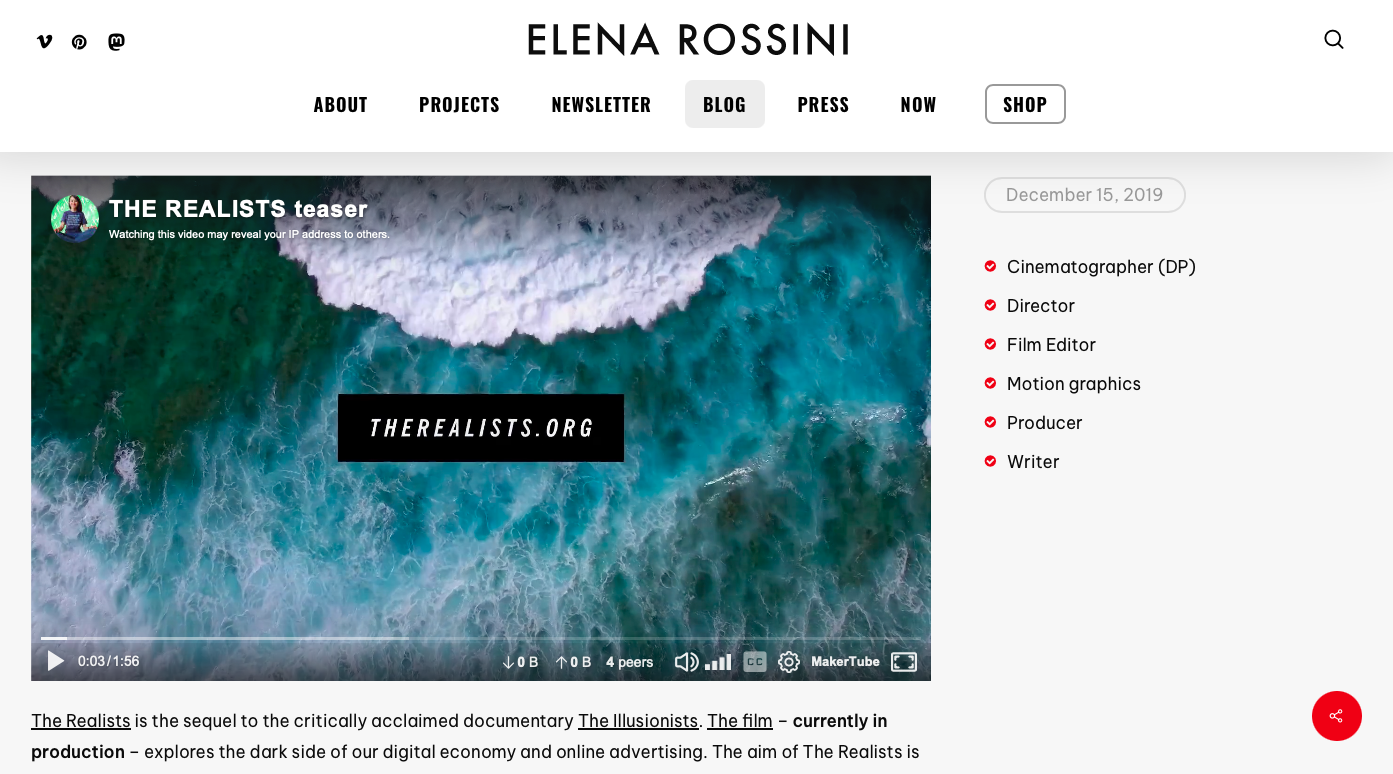
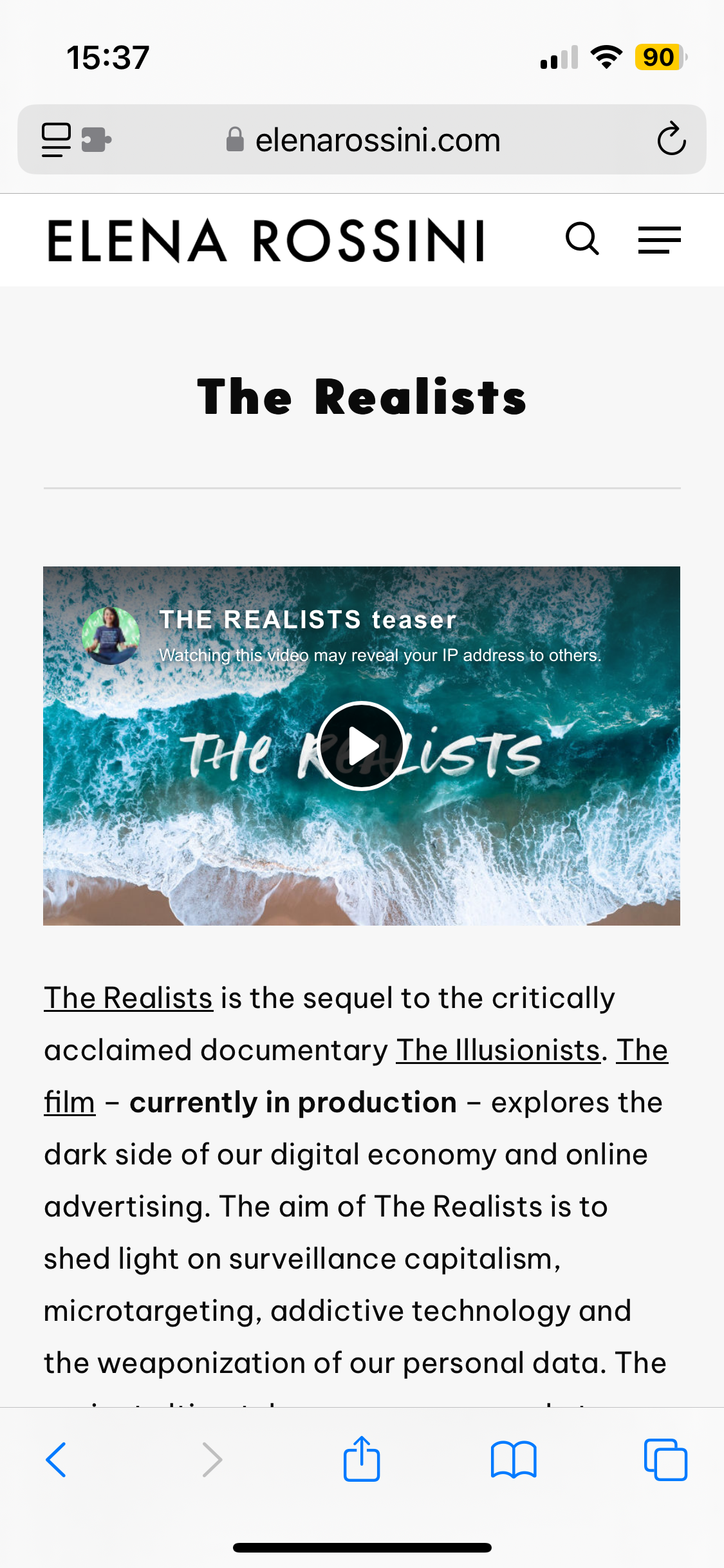
a screenshot of my website with the PeerTube video player embedded on the page for my project The Realists. shown on desktop (left) and mobile (right)
Great experience overall, after solving the initial bug.
If you want to check it out yourself, here is the link to the page:

Final thoughts
Would I recommend PeerTube to filmmakers and video creators? YES ABSOLUTELY. I’m so smitten with it, now I want to set up my own PeerTube instance to gain even more control over my videos and data.
Please take all this with a grain of salt because I’ve only been using PeerTube - as a creator - for 48 hours. Next week I will run an interview with Paige Saunders, a seasoned video creator who has extensive experience with both PeerTube and YouTube. I learned a lot from his observations and I look forward to sharing his wisdom with you.
As always, thanks for being here.
Elena
P.S.: you can find all the posts for The Future is Federated at the link below (21 now!)

💓 Did you enjoy this post? Share it with a friend!
👫 Follow me on Mastodon (my favorite network!) and Pixelfed. All my other social media links are available here.
📽️ If you'd like to support my work, you could buy or rent my documentary The Illusionists on the globalization of beauty. Watch the opening on Vimeo:

💌 If you'd like to say hi, my contact information is here
✏️ If this post resonated with you, leave a comment!

